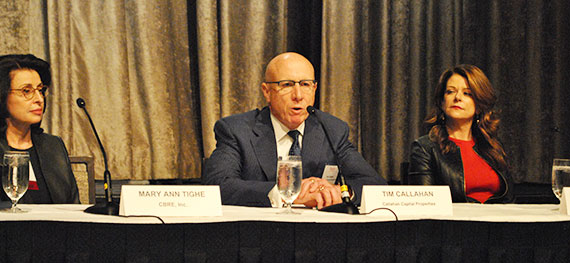Trending
NYC office development ain’t what it used to be: experts
Tighe, Levinson talk overbuilding, flipping at REBNY panel

Some of the exuberance has faded from the New York City’s office market in recent months, and developers will need to play it very smart when building new product, industry experts said Wednesday.
“I hear all the time: ‘Is New York getting overbuilt on office space?’ Because people are using less space to accomplish what they want and, indeed, taking temporary space from these various coworking [companies],” Mary Ann Tighe of CBRE said at the Hilton Hotel during a Real Estate Board of New York luncheon to discuss 2016 trends.
Tighe moderated a panel with Tim Callahan of Callahan Capital Properties, MaryAnne Gilmartin of Forest City Ratner and L&L Properties’ David Levinson, who were all bullish on the city’s office market for the long term. But the experts did urge caution when developing to meet demand in today’s market.
“I think we’ve passed that point in the cycle where flipping is as easy as it was,” said Callahan, whose company partnered with Ivanhoe Cambridge earlier this year to buy 3 Bryant Park for $2.2 billion. As landlords look to hold properties for longer periods and tenants demand modern spaces, it’s “caused us as owners to have to put maybe more cash in than we think at this point in the cycle, as those costs continue to go up.”
“There’s a lot of capital that has to go into every building on an ongoing basis,” he added. “And I think that challenge has always existed in our business but I think over the next couple of years more so than ever, because on the other side of [those tenant improvements] is more money that the actual tenant has to put in.”
The steering committee in charge of studying Midtown East released its report last week outlining greater building density for the area. Levinson, whose company is repositioning the mid-century 390 Madison Avenue, said that with ground-up construction costs at sky-high levels, savvy developers would do well to reconfigure older building stock.
Addressing a crowd of several hundred who gathered in the Hilton’s grand ballroom, Tighe said that “densification” is the word on everyone’s mind, and while she hasn’t seen the kinds of concessions that usually come with a shifting market, there are signs that tenants are beginning to push back.
“I’m feeling the rumblings of loss factor becoming a discussion again,” she said.
(Loss factor in Manhattan for a full-floor tenant is typically about 27 percent, while multi-tenant floors typically see a loss factor of between 35 and 38 percent, according to Peter Boritz, CEO of Real Data Management, which measures office space for major landlords.)
Gilmartin said that Brooklyn’s office-conversion market has been helped by tax benefits and that rents are beginning to rise to the level she thinks will spur new, ground-up development — though that may take some creative thinking.
“In Brooklyn it’s a particularly puzzling problem,” she said. “I like to remind everyone that it costs exactly the same amount to build an office building in Brooklyn as it does in Manhattan.”
“In the world of vertical living and livable cities, it is now an acceptable proposition to look at an office building that has a core that performs both as an office building and a condominium tower at top,”Gilmartin added. “I think these kinds of creative solutions are going to have to be brought into the equation for the math to work.”





